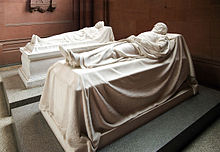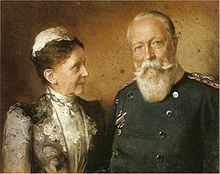Luise of Prussia (1838–1923)


Princess Luise of Prussia , VA (born December 3, 1838 in Berlin , † April 23, 1923 in Baden-Baden , full name Princess Luise Marie Elisabeth of Prussia ) was a member of the House of Hohenzollern and by marriage Grand Duchess of Baden .
Childhood and youth
Princess Luise was the only daughter of Prince Wilhelm of Prussia, the future German Emperor Wilhelm I (1797-1888), and his wife Princess Augusta of Saxe-Weimar-Eisenach (1811-1890), the second daughter of Grand Duke Carl Friedrich and the Russian Grand Duchess Maria Pavlovna Romanowa . Her paternal grandparents were the Prussian King Friedrich Wilhelm III. and his wife Princess Luise of Mecklenburg-Strelitz .
Together with her older brother Friedrich Wilhelm - the later German Emperor Friedrich III. (1831–1888) - Luise grew up in Berlin, where, as a nine-year-old girl, she experienced the revolution that was beginning in Prussia . The emperor's fondness for the cornflower is said to go back to his daughter, who adorned her father's study with bouquets and wreaths. In 1849 he was appointed Governor General of the Rhineland and Westphalia and disappeared from the public eye in Berlin. In the spring of 1850, the family followed him to the new residence in the former electoral palace in Koblenz .
Luise von Prussia was privately tutored by teachers chosen by her mother. She had her daughter instructed in the humanities and “princely virtues”. This included visits to orphanages , hospitals and charity banquets. Since 1850 the Princess of Koblenz came to Baden-Baden for an annual summer stay. Only a few weeks after her confirmation, which she celebrated in May 1855 in the Charlottenburg Palace Chapel , she was introduced to the then Prince Regent Friedrich von Baden (1826–1907). The engagement was announced publicly in Koblenz in September of the same year.
Marriage and offspring
On September 20, 1856 a few days after his proclamation to the Grand Duke of Baden, married Princess Luise in Berlin City Palace the Baden Grand Duke Friedrich I (1826-1907), the second son of Grand Duke Leopold I of Baden and Princess Sophie Wilhelmine of Holstein-Gottorp . The marriage had three children:
- Friedrich (II.) Wilhelm Ludwig Leopold August, called Fritz (1857–1928), later Grand Duke of Baden
- Sophie Marie Viktoria , called Vicky (1862–1930) ⚭ Gustav V (1858–1950), King of Sweden.
- Ludwig Wilhelm Karl Friedrich Berthold (1865–1888), Grand Ducal Prince of Baden
Later years
Like her sister-in-law, the British princess and German Empress Victoria , Luise of Prussia was considered an opponent of Bismarck .
In 1859, Grand Duchess Luise founded the first Baden women's association in Karlsruhe , the forerunner of the Red Cross Sisterhood. The Baden women's association was in charge of courses and training in housekeeping. In 1886 the first housekeeping school was set up in Pforzheim . In Baden , more precisely Schopfheim 1885, there were also the first so-called traveling cooking courses. These took place mainly in the winter months, the women's clubs provided teachers and the (mobile) kitchen equipment. With increasing interest from regional authorities, the courses were held longer. With the increasing number of permanent facilities in Baden, the hiking schools lost their importance even before the First World War. Luise had campaigned for the establishment of a stationary school kitchen in Lichtental (Baden-Baden) , among other places .
In 1871 she was awarded the Württemberg Olga Order .
On September 20, 1881 (on the day of the silver wedding ), the marriage of the daughter Viktoria with the Crown Prince and later King Gustav V of Sweden took place. In 1885, Hereditary Grand Duke Friedrich married Princess Hilda of Nassau .
On October 1, 1885, the painting school was opened under their patronage. The school existed until 1923.
When the grand-ducal couple returned in 1888 from the sick bed of the German Crown Prince in San Remo, they learned in Basel of the unexpected death of their second son Ludwig Wilhelm, who died on February 23 in Freiburg at the age of 23. Immediately afterwards, Luise had to mourn her father's death on March 9th. Then on June 15 she lost her only brother, Emperor Friedrich III, and two years later she mourned the death of her mother, Empress Augusta. Increasingly, Luise also had physical complaints. In 1897, a successful cataract operation brought noticeable relief to her protracted eye problems. Once again, the Grand Duchess celebrated two family celebrations: her husband's 80th birthday (September 9, 1906) and her golden wedding anniversary just a few days later. A year later, on September 28, 1907, her husband died.
In her honor, on her 58th birthday in 1896, the people of Mannheim gave her the newly created large park as a present and have since called it Luisenpark . Today it is one of the most beautiful parks in Europe .
In 1917 the Medical Faculty of the TH Karlsruhe awarded her an honorary doctorate . In November 1918, the military collapse of the Reich also meant the end of the monarchy in Germany. After fleeing the residence, Luise lived briefly in between ( Zwingenberg Castle on the Neckar and Langenstein Castle in Hegau ), initially on Mainau Island , until she was able to move to Baden-Baden Castle in late summer 1919. There she died in 1923 at the age of 84. Her tomb, designed by Hermann Volz , is located in the grand ducal burial chapel in Karlsruhe , together with that of her husband and that of her son Ludwig-Wilhelm .
Honors
- 1896 Luisenpark in Mannheim
- 1917 honorary doctorate from TH Karlsruhe
- Bust on the island of Mainau
- 2017 Naming of a hybrid tea rose "Grand Duchess Luise" (Parfuma scented rose) by W. Kordes' sons
Publications
- Luise Grand Duchess of Baden: I know that my Redeemer lives! Words of Faith for Days of Trial . Velhagen & Klasing, Bielefeld / Leipzig 1910
See also
literature
- Hans v. Pezold : Grand Duchess Luise of Baden . In: Deutsches Adelsblatt . 1933.
- Leonhard Müller: About the reform of daughter education. A memorandum from Grand Duchess Luise von Baden . In: Journal for the history of the Upper Rhine . No. 153 , 2005, pp. 531-543 .
- Ilona Scheidle: Queering biography. Methodological considerations using the example of the biography of Grand Duchess Luise von Baden (1838–1923) . In: Susanne Blumesberger, Ilse Korotin, (Ed.): Biography research. Theoretical discourses and methodological concepts . Vienna 2012, pp. 488-513.
- Ilona Scheidle: Emancipation as a duty - Grand Duchess Luise von Baden. In: Journal for the history of the Upper Rhine , 152 year, 2004, pp. 371–395.
- Clemens Siebler: Baden-Württemberg portraits . Ed .: Elisabeth Noelle-Neumann . Deutsche Verlags-Anstalt, Stuttgart 1999, ISBN 3-421-05271-9 , pp. 137-144 .
- About the effectiveness of the Baden Women's Association. Newspaper article from 1878
Web links
- Literature by and about Luise von Prussia in the catalog of the German National Library
- Estate of Grand Duchess Luise von Baden in the General State Archives Karlsruhe [1]
Individual evidence
- ↑ The cornflower of the German emperor. In: Neuigkeits-Welt-Blatt , September 5, 1878, p. 7 (online at ANNO ).
- ^ Ko: Grand Duchess Luise von Baden - The mother of the Red Cross . In: Badische Zeitung , November 18, 2012, p. 30. Kurt Bickel: Luise von Baden - The forgotten mother of the Red Cross. DRK district association Karlsruhe, Karlsruhe 2011
- ↑ a b Kramer, pp. 30-35
- ↑ Kramer, pp. 90-91
- ^ Johannes Kramer: The rural domestic education system in Germany, dissertation at the University of Erlangen, Fulda 1913
- ^ Court and State Handbook of the Kingdom of Württemberg . 1901, p. 160
- ↑ Luise von Prussia on ka.stadtwiki.net
| personal data | |
|---|---|
| SURNAME | Luise of Prussia |
| ALTERNATIVE NAMES | Luise Marie Elisabeth Princess of Prussia (full name) |
| BRIEF DESCRIPTION | Princess of Prussia, by marriage Grand Duchess of Baden |
| DATE OF BIRTH | December 3, 1838 |
| PLACE OF BIRTH | Berlin |
| DATE OF DEATH | April 23, 1923 |
| Place of death | Baden-Baden |

